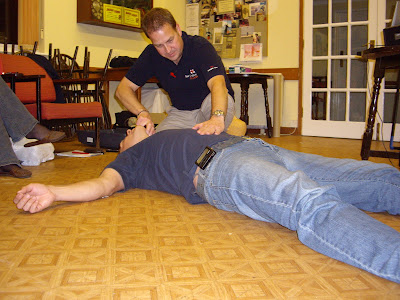
One of the particularly enjoyable parts of blogging is receiving comments from people. I know that many people read this daily but sometimes it can be rather like working in a void.........you talk lots but get no response! So I was delighted last night to get a comment from the legendary
Dr Douglas Wilcox; sea kayaking photography guru. He had read the post about capsizing 'D' class lifeboats and had a few questions. I'll try to answer them:
Douglas noted that capsizing at night sounds horrendous. I wouldn't know, I've never done it, and hope it never happens, but he's quite probably right. It's pretty disorientating to be under a capsized boat by day, I can only imagine it would be worse at night. The already small space between the upturned hull and the sea becomes more confined as the padded mat falls from the floor onto your heads. You struggle to find the handheld, flares and rope in the dark confined space. Yep, I think you're spot on Douglas...........horrendous by night! Incidentally, in the new wave pool at the training college in Poole, crews can practise this in a simulated environment which has darkness, waves, thunder, lightening, wind, rain and cold. It's so realistic that many people get seriously sea-sick in there. Wenley has posted a 'youtube' film on his blog which gives you an idea of what this might be like,
have a look here.
Douglas also asked about the procedure for restarting the engine. To be honest it is surprisingly reliable and simple, just time consuming. The system is different for the old 40hp mariner engines on 'D'class boats and the 50 hp on the new IB1s.
On the older 40hp the instructions are on the inside of the engine lid, they read: Step 1, remove lid! There then follows a sequence (which I can't remember) involving removing the plugs, pulling the engine over by hand, replacing the plugs with new ones, pulling it over some more, then trying to re-start it. Generally it works.
On the IB1 the 50 hp is fitted with a 'PIRS' (post inversion recovery system), this simplifies things. Again, I honestly don't remember the system but think it involves pulling out a lever, removing the fuel lead, turning it over (using battery) for a while, replacing fuel lead and trying to start it. This always works. I can't remember if the plugs need replacing but I suspect they might.
As for Douglas's question about how many capsize, I'm afraid I don't know but I will try to find out. I suspect that it is not that many as there is an upper operating limit for the 'D'class. I also have a feeling that as many happen in training as on shouts. I would imagine that most happen in surf and not in horrendous rough weather. I will try to clear this one up............
I guessed that Dave our mechanic might have read this and had something to add, he's now done this so for extra details read the comments below. He's right too, it's a long time now since I've been in our IB1, I will find an opportunity to rectify this soon.
 To begin, Skid was ill, he makes a good patient 'cause he has a natural tendency to look poorly!
To begin, Skid was ill, he makes a good patient 'cause he has a natural tendency to look poorly! I got to pretend to be a 'bent diver' (that is, a diver with the bends). I was only allowed to breath once every 13 seconds.
I got to pretend to be a 'bent diver' (that is, a diver with the bends). I was only allowed to breath once every 13 seconds. Then John acted out a Diabetic who was Hypo. And very convincing he was too (think drunk and randomly aggressive), a bit of type casting perhaps?
Then John acted out a Diabetic who was Hypo. And very convincing he was too (think drunk and randomly aggressive), a bit of type casting perhaps? Nick and I then got the pleasure of Matt after a stroke. We stuck to our assessment and it worked. We treated the symptoms and ultimately figured out what was the matter with him. Very satisfying.
Nick and I then got the pleasure of Matt after a stroke. We stuck to our assessment and it worked. We treated the symptoms and ultimately figured out what was the matter with him. Very satisfying.



























